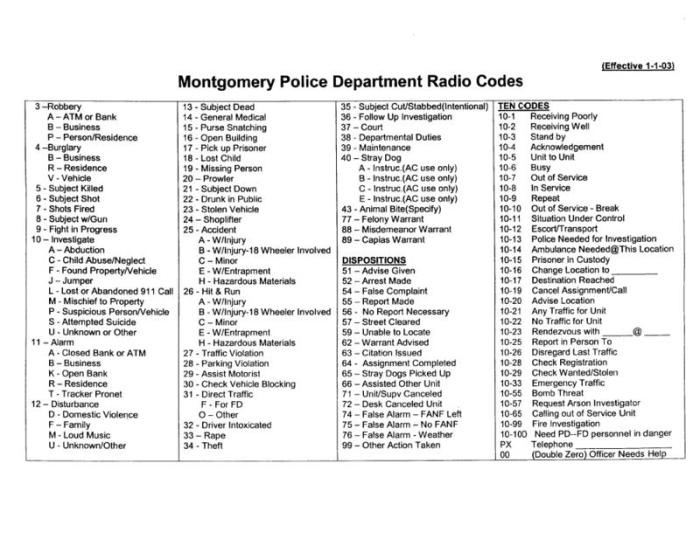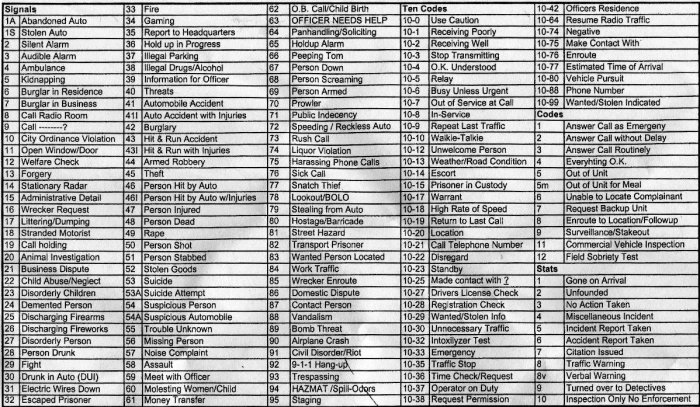Unveiling the enigmatic world of Ohio police codes and signals, this guide embarks on a captivating journey into the communication protocols that safeguard the Buckeye State. From their significance to their enforcement, this exploration unveils the intricacies of how Ohio’s finest maintain order and protect their communities.
Ohio police codes and signals serve as a vital lifeline, enabling law enforcement officers to convey critical information swiftly and effectively. These codes and signals, ranging from routine dispatches to urgent alerts, form the backbone of communication within the Ohio law enforcement community.
Ohio Police Codes and Signals Overview
Ohio police codes and signals are a standardized system of communication used by law enforcement officers in the state of Ohio. These codes and signals allow officers to quickly and efficiently convey important information during emergency situations or routine traffic stops.
The purpose of these codes and signals is to enhance officer safety, improve communication accuracy, and facilitate interoperability between different law enforcement agencies. By using standardized codes, officers can ensure that their messages are understood by all parties involved, regardless of their location or agency affiliation.
Ohio police codes and signals provide a standardized way for officers to communicate. Understanding these codes is crucial for interpreting police reports and staying informed about local law enforcement activities. If you’re interested in delving deeper into the intricacies of government, check out the ap gov ultimate review packet . This comprehensive resource covers everything from the Constitution to the Supreme Court, equipping you with the knowledge to navigate the complexities of our political system.
Returning to the topic of Ohio police codes and signals, it’s worth noting that these codes are regularly updated to ensure effective communication among officers.
Types of Codes and Signals
Ohio police codes and signals can be categorized into several different types, including:
- 10-Codes:Numeric codes used to convey specific messages or requests, such as “10-4” (acknowledgment) or “10-20” (location).
- Signal Codes:Single-letter codes used to indicate the status of an officer or unit, such as “A” (available) or “U” (unavailable).
- Traffic Codes:Codes used to describe traffic violations or incidents, such as “454” (speeding) or “599” (accident).
- Directional Codes:Codes used to indicate the direction of travel or location of an incident, such as “N” (north) or “E” (east).
Types of Ohio Police Codes: Ohio Police Codes And Signals

Ohio police codes are a system of standardized codes used by law enforcement agencies in the state of Ohio to communicate efficiently and effectively.
There are several different types of Ohio police codes, each with its own specific purpose and usage. Some of the most common types of codes include:
Traffic Codes
- 10-4: Traffic stop
- 10-10: Accident
- 10-13: Drunk driving
- 10-15: Speeding
Investigative Codes
- 20-20: Suspicious person
- 20-25: Burglary in progress
- 20-30: Robbery in progress
- 20-35: Assault in progress
Officer Safety Codes
- 30-30: Officer needs assistance
- 30-35: Officer down
- 30-40: Officer in pursuit
- 30-45: Officer involved in a shooting
Miscellaneous Codes
- 40-40: Animal control
- 40-45: Domestic disturbance
- 40-50: Medical emergency
- 40-55: Fire
Ohio Police Signal Procedures
Ohio police officers follow established procedures when using signals to ensure effective communication and coordination during operations. These procedures Artikel the standard operating guidelines for transmitting, responding to, and acknowledging signals.
Methods of Transmitting Signals
Ohio police officers utilize various methods to transmit signals, including:
- Verbal communication:Officers may use verbal commands or phrases over radio or telephone systems to convey messages.
- Electronic signals:Police vehicles are equipped with electronic sirens, lights, and other devices that emit audible and visual signals.
- Hand signals:Officers may use hand gestures to direct traffic, indicate movements, or communicate with other officers.
- Written signals:In certain situations, officers may use written notes or messages to convey information.
Protocols for Responding to and Acknowledging Signals, Ohio police codes and signals
When receiving a signal, Ohio police officers are expected to respond promptly and acknowledge its receipt. The specific protocols vary depending on the type of signal and the situation:
- Verbal commands:Officers should respond verbally to acknowledge receipt and understanding of the command.
- Electronic signals:Officers should activate their vehicle’s lights or sirens to acknowledge receipt of an emergency signal.
- Hand signals:Officers should make eye contact and nod or gesture to indicate acknowledgment.
- Written signals:Officers should sign or initial the written message to indicate receipt and understanding.
Code and Signal Training

Ohio law enforcement officers undergo rigorous training to master the state’s police codes and signals. This training is crucial for ensuring clear and effective communication during emergency situations.
Training Process
The training process typically involves classroom instruction, simulations, and field exercises. Officers learn the meanings and proper usage of various codes and signals, as well as the protocols for transmitting and receiving them.
Importance of Proper Training
Proper training is essential for several reasons. It helps officers:
- Understand the nuances of each code and signal
- Transmit and receive information accurately and quickly
- Avoid misunderstandings and confusion during emergencies
Training Exercises and Scenarios
Training exercises and scenarios play a vital role in preparing officers for real-life situations. These exercises simulate various scenarios, such as:
- Responding to a traffic stop
- Chasing a suspect
- Communicating with other officers during a large-scale incident
By participating in these exercises, officers gain practical experience in using codes and signals, enhancing their ability to communicate effectively and respond appropriately to emergencies.
Code and Signal Enforcement
Ensuring proper use of police codes and signals is crucial for effective communication and public safety. Various enforcement mechanisms are in place to maintain compliance.
Misuse or unauthorized use of codes and signals can have serious consequences. Violators may face disciplinary action, suspension, or even termination of employment.
Supervisory Personnel
Supervisory personnel play a vital role in enforcing code and signal compliance. They are responsible for:
- Monitoring officer communications to ensure proper use of codes and signals.
- Providing training and guidance to officers on code and signal procedures.
- Investigating and taking appropriate action against any misuse or unauthorized use.
Popular Questions
What is the purpose of Ohio police codes and signals?
Ohio police codes and signals facilitate rapid and efficient communication among law enforcement officers, enabling them to convey critical information regarding incidents, suspect descriptions, and requests for assistance.
How are Ohio police codes and signals enforced?
Supervisory personnel play a crucial role in enforcing proper use of codes and signals. Misuse or unauthorized use can result in disciplinary action or other consequences.